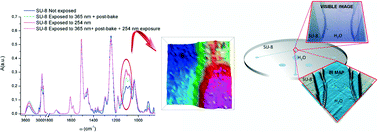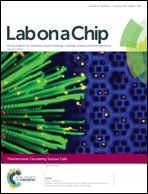SU-8 bonding protocol for the fabrication of microfluidic devices dedicated to FTIR microspectroscopy of live cells†
Abstract
Here we present a new bonding protocol for SU-8 negative tone photoresist that exploits the chemical modifications induced in the resin by exposure to 254 nm (UVC) light. Fourier Transform Infrared microspectroscopy (μ-FTIR) was used to carry out a thorough study on the chemical processes and modifications occurring within the epoxy resin by exposure to 365 nm and 254 nm light. In particular, we established that UVC light promotes the opening of the epoxy rings bypassing the post-exposure bake. The possibility to promote a further activation of the resin, already patterned with standard UV lithography, was exploited to produce closed microfluidic devices. Specifically, we were able to fabricate fluidic chips, characterized by broadband transparency from mid-IR to UV and long term stability in continuous flow conditions. CaF2 was used as substrate, coated by sputtering with a nanometric silicon film, in order to make surface properties of this material more suitable for standard fabrication processes with respect to the original substrate. The fabricated microfluidic chips were used to study by μ-FTIR the biochemical response of live breast cancer MCF-7 cells to osmotic stress and their subsequent lysis induced by the injection of deionized water in the device. μ-FTIR analyses detected fast changes in protein, lipid and nucleic acid content as well as cytosol acidification.


 Please wait while we load your content...
Please wait while we load your content...